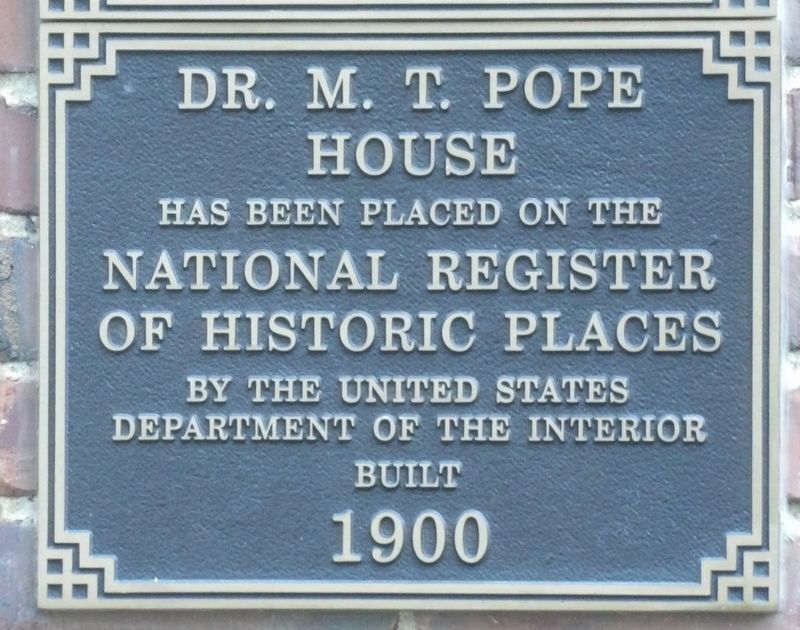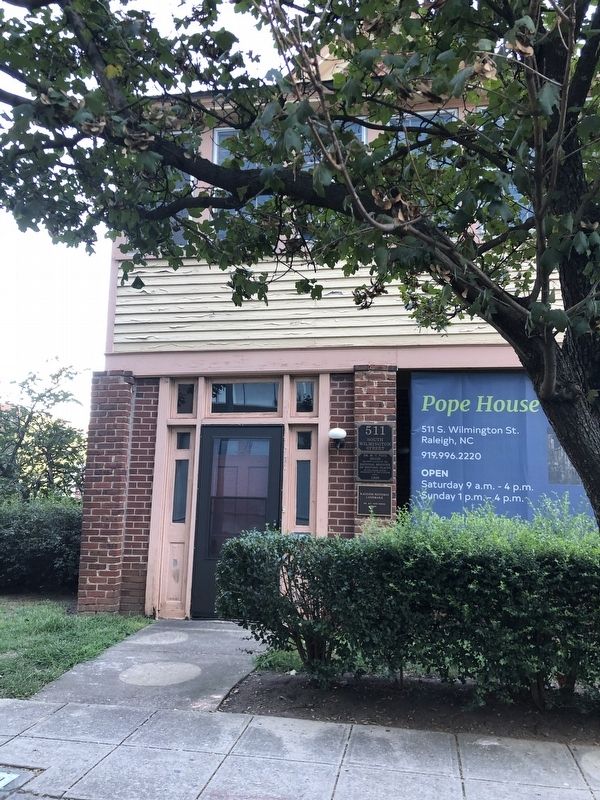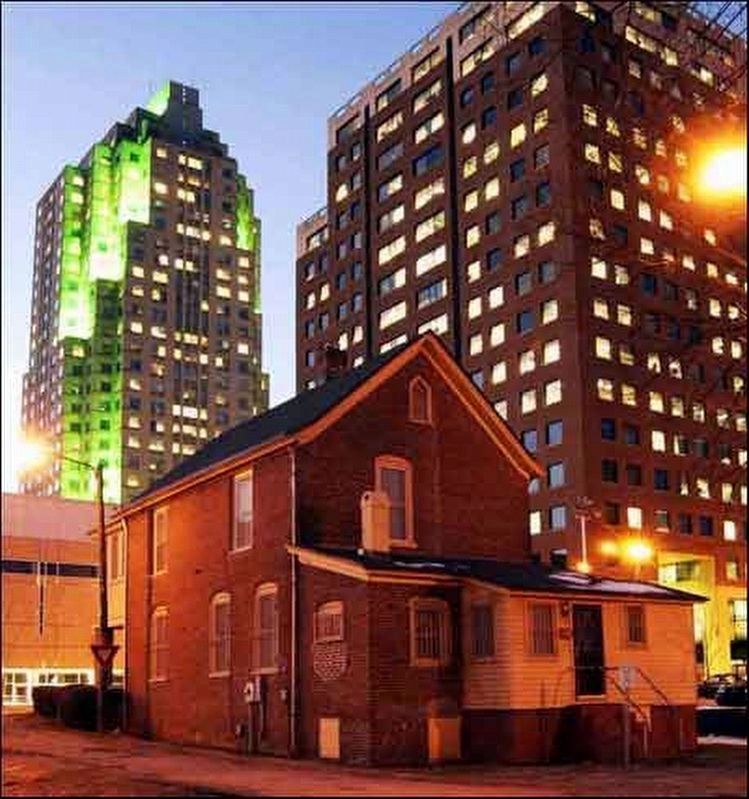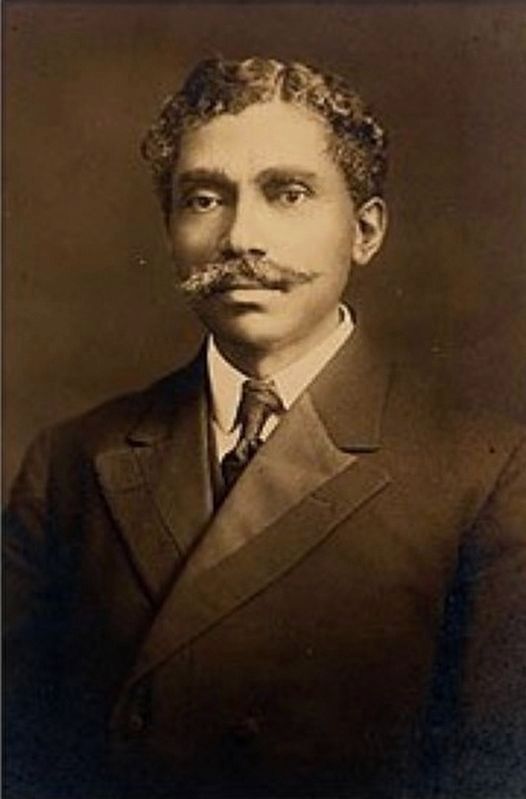Downtown in Raleigh in Wake County, North Carolina — The American South (South Atlantic)
Dr. M.T. Pope House
National Register
of Historic Places
by the United States
Department of the Interior
Built
1900
Topics and series. This historical marker is listed in these topic lists: African Americans • Architecture • Civil Rights • Science & Medicine. In addition, it is included in the National Register of Historic Places series list. A significant historical year for this entry is 1900.
Location. 35° 46.423′ N, 78° 38.3′ W. Marker is in Raleigh, North Carolina, in Wake County. It is in Downtown. Marker is at the intersection of South Wilmington Street and Stronachs Alley, on the right when traveling north on South Wilmington Street. Touch for map. Marker is at or near this postal address: 511 S Wilmington St, Raleigh NC 27601, United States of America. Touch for directions.
Other nearby markers. At least 8 other markers are within walking distance of this marker. Tupper Memorial Baptist Church (about 500 feet away, measured in a direct line); Governor’s Palace (about 600 feet away); General Grant (about 600 feet away); Rogers-Bagley-Daniels-Pegues House (about 600 feet away); Shaw University (about 600 feet away); Governor’s Palace of North Carolina (about 700 feet away); Lafayette's Tour (about 700 feet away); Estey Hall (about 800 feet away). Touch for a list and map of all markers in Raleigh.
Regarding Dr. M.T. Pope House. Excerpts from the National Register nomination:
The 1900 M. T. Pope House is significant to the city of Raleigh as the last surviving structure from a once-thriving middle and professional class African American neighborhood, created in the capital city at the beginning of racial segregation at the turn of the twentieth century. For much of this century Raleigh had several such viable and active African American communities (now largely gone), which contained important educational and religious institutions and thriving commercial areas. Built by Dr. M. T. Pope, an African American physician and entrepreneur, this house is associated with an important period of history in Raleigh, and is significant to the area's social history and ethnic heritage. …
Dr. Manassas Thomas Pope was born in 1858 in Rich Square, Northhampton County, North Carolina, to parents who were free persons of color. … Nothing is known of Dr. Pope's early life, though he graduated with a degree in medicine from the Leonard Medical School at Shaw University in Raleigh in 1885. After practicing for a few years in Henderson, North Carolina, Dr. Pope moved to Charlotte, where he and two other men formed the Queen City Drug Company in November of 1892. … This grew to be one of the most successful African American businesses in Charlotte during the 1890s.
In July of 1898 he enlisted in the 3rd North Carolina Voluntary Infantry as an officer and surgeon, and served during the Spanish-American War until he was discharged in February of 1899. Dr. Pope returned to Charlotte after the war, but for reasons that are unknown he decided to move to Raleigh, where he was living by early June of 1899. … By 1900 he completed construction of his residence at 511 S. Wilmington Street.
Also see . . .
1. Dr. M.T. Pope House (PDF). National Register nomination submitted for the house, which was listed in 1999. (Prepared by Kenneth Joel Zogry; via National Archives) (Submitted on September 27, 2023, by Duane and Tracy Marsteller of Murfreesboro, Tennessee.)
2. Dr. M.T. Pope House. This two-story brick residence is the last surviving building from a once-thriving neighborhood of middle and professional class African Americans, defined by the racial segregation of early 20th-century Raleigh. ("Raleigh: A Capital City", National Park Service) (Submitted on September 27, 2023, by Duane and Tracy Marsteller of Murfreesboro, Tennessee.)
3. Historical Context for the Pope Family (PDF). Dr. Pope’s political activity reached a high point in the spring of 1919, when, in the midst of Jim Crow segregation and at a moment of extreme racial tension in the nation, he courageously ran for mayor of Raleigh.
(City of Raleigh) (Submitted on September 27, 2023, by Duane and Tracy Marsteller of Murfreesboro, Tennessee.)
4. Historical Context for the Pope House (PDF). It was in the relatively prestigious Third Ward that Dr. Pope decided to build his house in 1901. Though not legally restricted from living anywhere else at that time, he certainly would have been unwelcome along Hillsborough Street or Glenwood Avenue where professional white families were building new homes. The 500 block of South Wilmington Street offered a good alternative, and was something of a buffer zone between white and black Raleigh. (City of Raleigh) (Submitted on September 27, 2023, by Duane and Tracy Marsteller of Murfreesboro, Tennessee.)
Credits. This page was last revised on September 27, 2023. It was originally submitted on September 27, 2023, by Duane and Tracy Marsteller of Murfreesboro, Tennessee. This page has been viewed 62 times since then and 22 times this year. Photos: 1, 2, 3, 4. submitted on September 27, 2023, by Duane and Tracy Marsteller of Murfreesboro, Tennessee.



